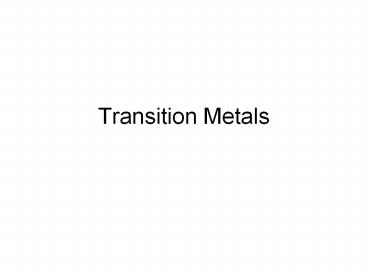Transition Metals PowerPoint PPT Presentation
1 / 21
Title: Transition Metals
1
Transition Metals
2
Definitions
- Complex A metal ion surrounded by ligands.
- Ligand an electron pair donor i.e. a molecule
or ion joined onto the metal ion by a dative
covalent bond to the metal. - Coordination number The number of atoms
directly joined to a transition metal by a
coordinate (dative covalent) bond.
3
Typical ligands
- Unidentate H2O NH3 Cl-
- Bidentate C2O42- H2NCH2CH2NH2
- Multidentate EDTA4-
- Watch out for the chelate effect.
4
Shapes
- Six-coordinate complexes are octahedral.eg
Cu(H2O)62 Co(NH3)63 - Four-coordinate complexes are usually tetrahedral
eg CoCl42- but a few are square planar eg
Ni(CN)42-. - Two-coordinate complexes are linear eg AgCl2-.
5
Colour
- Most transition metal colours are due to d-d
electron transitions. The energy gap between the
split d-orbitals corresponds to visible light
(Ehf). - Some of the really strong colours are due to
charge transfer (such as in MnO4-).
6
Changing colour
- Anything that changes the energy difference
between the d-orbitals causes a change in colour - Oxidation state
- Ligand
- Coordination number
7
Measuring concentration by colour
- A measurement of colour intensity (using a
colorimeter) can measure the concentration of a
solution. - Sometimes a special complex is formed so that the
colour is more intense. - This is known as UV/visible spectroscopy.
- eg Fe(H2O)63 SCN- Fe(H2O)5(SCN)2
H2O
8
Reaction types
- The reactions of the transition metals come under
three headings (but sometimes more than one
occurs at the same time!). - Ligand substitution
- Hydrolysis (the acidity reaction)
- Redox
9
Ligand substitution
- One kind of ligand is replaced by another.
- For example,
- Cu(H2O)62 4Cl- ? CuCl42- 6H2O
10
Hydrolysis (the Acidity reaction)
- One or more hydrogen ions is removed.
- For example,
- Cu(H2O)62(aq) 2OH-(aq) ?
- Cu(H2O)4(OH)2(s) 2H2O(l)
11
Redox
- The oxidation state of the metal is changed by
adding or removing one or more electrons - For example,
- Co(NH3)62 ? Co(NH3)63 e-
12
Titanium
- Mainly known for its chloride, TiCl4, as part of
the Kroll process for extraction of titanium from
its ores. - The chloride is covalently bonded.
- Titanium oxide, TiO2 , is used as a white pigment.
13
Vanadium
- Most stable form is V(IV) eg as VO2.
- V(V) can be reduced in acidic conditions (eg Zn /
HCl) - VO2 ? VO2 ? V(H2O)63 ? V(H2O)62
- V(H2O)62 is unstable in air since it is
oxidised by oxygen.
14
Chromium
- Cr(H2O)63 Cr(H2O)3(OH)3 Cr(OH)63-
- gtgtgtgtIncreasingly alkaline conditionsgtgt
Cr2O72- CrO42- ltltltltIncreasingly alkaline
conditionsltltltlt
15
Manganese
- Mn(H2O)62 MnO2 MnO42- MnO4-
- II IV VI
VII - v. pale pink brown deep
purple
MnO4- is a very strong oxidising agent. Use
acidic conditions. For titrations, make sure you
add sufficient sulfuric acid to take Mn all the
way to Mn2. Otherwise you get incomplete
reduction (the brown solid, MnO2 is formed,
rather than Mn2).
16
Iron
- Fe(H2O)62 is non-acidic in water (green).
- Pure Fe(H2O)63 is a lilac colour but on contact
with water goes rusty brown. - Fe(H2O)62 forms Fe(OH)2 (a green solid) with
NaOH but it goes brown (forming Fe(OH)3 on
standing in air.
17
Cobalt
- add ammonia solution
add hydrogen peroxide (or air) - Co(H2O)62 ? Co(NH3)62 ? Co(NH3)63
- pink
brown / yellow orange - CoCl42- Co(OH)2
- blue
blue-grey
Add conc HCl
Add NaOH or NH3 (aq)
18
Nickel
- add
ammonia solution - Ni(H2O)62 Ni(NH3)62
- green
blue
- NiCl42- Ni(OH)2
Ni(CN)42- - blue pale
green a square planar complex!
Add NaOH or NH3 (aq)
Add NaCN (aq)
Add conc HCl
19
Copper
- add ammonia solution
- Cu(H2O)62 Co(NH3)4(H2O)22
- blue
deep blue / violet - CuCl42- Cu(OH)2
- yellow-green pale
blue
Add conc HCl
Add NaOH or NH3 (aq)
20
Silver
- Small quantity of NaOH, NH3(aq)
excess NH3 (aq) - Ag(aq) Ag2O(s)
Ag(NH3)2 - Cl-
- AgCl(s)
- excess Cl-
- AgCl2- Ag(S2O3)23-
Ag(CN)2-
NaCN(aq)
Na2S2O3(aq)
21
Uses of transition metalsand their complexes
- V2O5 is used as a catalyst in the Contact
Process (manufacture of sulfuric acid). - Cis-platin (a platinum complex) is a very
effective anti-cancer drug. - Fe2 is an important part of haemoglobin.
- Ag(NH3)2 is Tollens reagent (test for
aldehydes). - Ag(S2O3)23- is formed during photographic
processing. - Ag(CN)2- is used in electroplating.

